



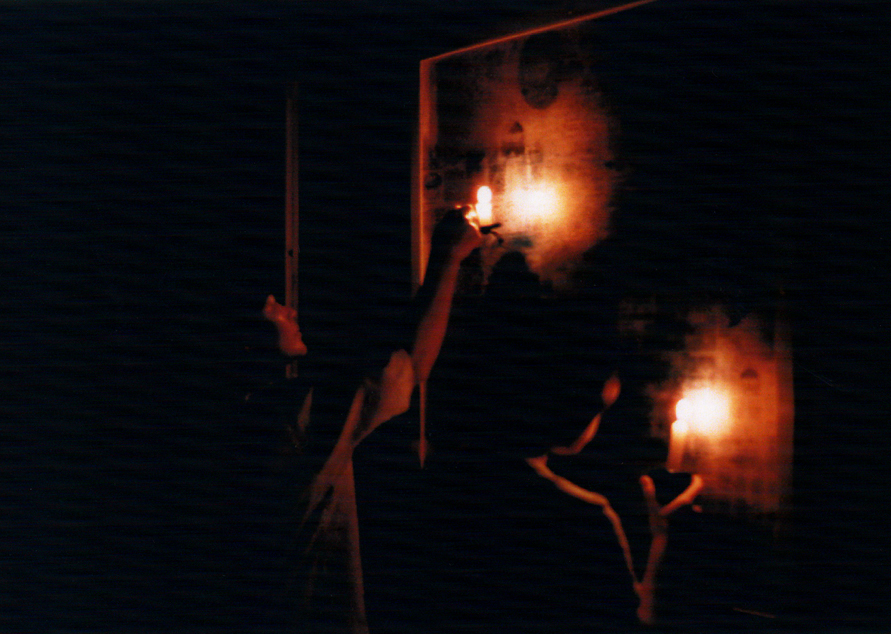
木枠に塩化ビニール, トナー, 背後にアクリル画(キャンバス), 1030mm × 1030mm, 1997年 / Wooden Flame, Vinyl Chloride Film, Toner, Acrylic on Canvas in the rear, 1030mm × 1030mm, 1997.
1997年に名古屋の現代美術の画廊ガレリアフィナルテで開いた個展で、これが私のはじめての個展でした。当時、私は、それまで描いていたアクリル絵具とキャンバスによる作品から現代美術の方向にシフトしていこうと模索を続けていたのですが、その集大成がこの個展になりました。
ガレリアフィナルテの展示空間は、扉部分を閉めきればほぼ真っ暗になるので、私は闇の中で作品を見せることを考えました。「本当に見たいものは見えない」これが、当時の私の基本的な考え方であり、それは今でも変わっていません。私は、単純にアクリル画を展示するのではなく、アクリル画の前に「邪魔物」、すなわち、木枠に張った二重のビニール膜にプリントしたさまざまなイメージを置くことを考え、これをOBSTA(オブスタ)と呼ぶことにしました。「本当の作品」であるアクリル画は、この二重の「オブスタ」に遮られて一部しか見えません。しかも、ビニール膜に画像をプリントする方法として、アイロンによる熱転写を使ったので(この方法をサーモプリントと名付けました)、ビニールが熱で白く濁り、磨りガラスのようになってますます見えにくくなります。これに加えて、ギャラリー空間は真っ暗。これでは本当になんにも見えないので、お客さんにはろうそくを持って入っていただくことにしました。……ところが、自分で照らしてみて気づいたんですが、ろうそくの光は意外に明るいのです。見えすぎ……かなと思っていたら、お客さんの中に、たった一人、ろうそくを拒否された方が……現代美術の世界では著名な水上旬さん。「ろうそくは不要です」とおっしゃって中に入って、長い間出てこられませんでした。うーん、さすが……と正直に思いました。人間の感覚って、ふだんはやっぱり過剰な刺激にさらされすぎている。闇の中でこそ見えてくるもの……のちに、ジェームズ・タレルさんの展覧会を見たとき、このときの水上さんの行動を思い出しました。死は、だれにでも平等にやってくる唯一のものかもしれませんが(生を除いて)、現代美術の一つの持ち味として、その「平等」をきちんと味わってみるということはあるのだと思います。いろいろ考えさせられた展覧会でした。
This is my first personal exhibition in 1997. The place was Galleria Finarte, which is one of contemporary art gallerys in Nagoya. I continued groping for possibility to shift to the direction of the contemporary art from acrylic paints on canvas which I painted till then, and the collected studies became this private exhibition in those days.
The display space of Galleria Finarte becomes approximately pitch-black if I shut up a door part. Therefore I thought that I showed my works in darkness. Therefore, I intended to show my works in darkness. "A person can't see the object which really want to see." This is my then basic way of thinking, and it is not still change. I did not display an acrylic simply and thought about putting various images formed on "an obstacle" that I printed on the double vinyl films which tensioned by a wooden frame before an acrylic, and thought to call these with OBSTA (obstacle). The acrylic which "is a true work" is shut out in these double "OBSTA", and a person can see only partly. Besides, because I used a method(I named this method as "thermo-print") which copying images to vinyl films by heat with an iron, so vinyl films became white muddy by heat like frosted glass, so the real work became hard to be seen more and more. In addition, the exhibition room is pitch-black, nothing really seen. Therefore I thought that I let a visitor enter with a candle. However, I lighted it up oneself and noticed that the light of the candle is unexpectedly bright. I thought it would be not good maybe to see more,……One day, there was one visitor who reject to have a candle. His name was Mr. Mizukami Jun, an well-known person as an artist in contemporary art. He said that "I don't need any light, thank you." And he entered in a pitch black room, and stayed a long time there. Mmm……after all he is Characteristic! Frankly I thought so. Probably the human sense is usually exposed to stimulation too much. There is an object which is really seen in darkness itself. When I saw the exhibition of James Turrell later, I remembered the behavior of Mr. Mizukami's at that time. A person loses all "senses" by death. The death may be the only phenomenon equally visiting to anyone except "live", and I think that it may be OK, that a person taste such "equality" as one of the characteristics of the contemporary art properly. Anyway, it was the exhibition which was made to think about various things.
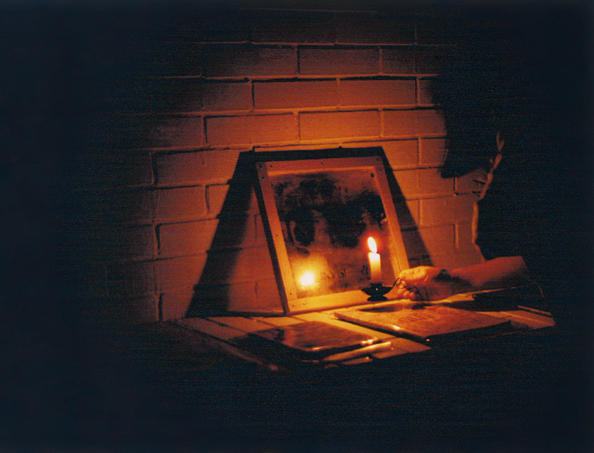
木枠に塩化ビニール, トナー, 450mm × 450mm, 1997年 / Wooden Flame, Vinyl Chloride Film, Toner, 450mm × 450mm, 1997.
ろうそくの光は、自分の手で持って動かせるという点が一つの特徴で、これはたぶん懐中電灯でも同じだと思うのですが、鑑賞者が光源を支配できるというのは、おそらく「見せられる」から「見る」へ一歩踏みこんだ位置にあると思います。それと、ろうそくをぐるぐる回して遊んでいる人もけっこう多く、これは、灯りを手に持つと思わずやってしまう人間の行動の一つなのかもしれません。
About the light of a candle, it's a big characteristic that a person with candle can move that light by oneself. Even a flashlight is the same, I thinks that the spectator has own source of light, it means that, he moves from the position of "a man who was shown a object" to the position of "a man who sees a object".
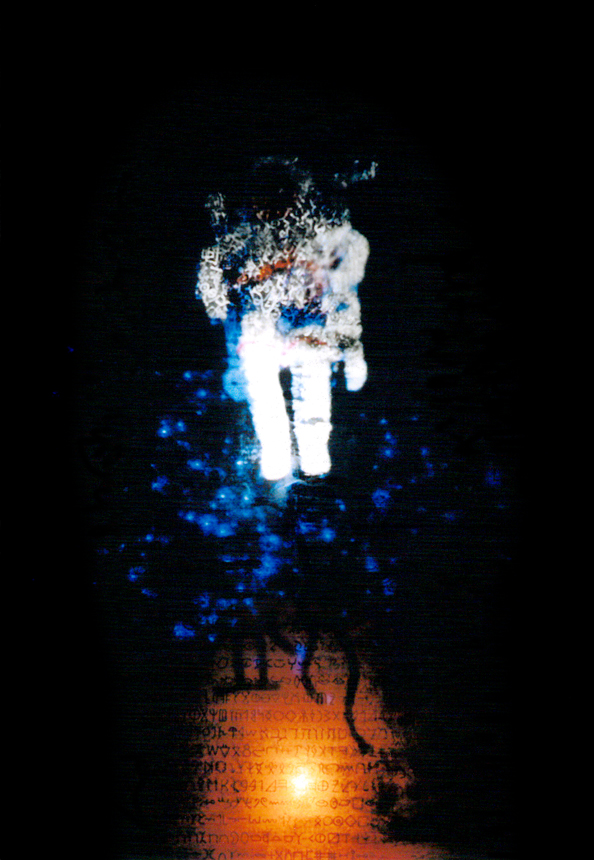
木枠に塩化ビニール, トナー, 背後にろうそくとスライドプロジェクター映像, 450mm × 450mm, 1997年 / Wooden Flame, Vinyl Chloride Film, Toner, Candle and Images by slide projector in the rear, 1030mm × 1030mm, 1997.
展覧会の会期中に、一日に何度か、木枠に張ったビニールフィルムにスライドプロジェクターでいろいろな映像を投影して楽しみました。この写真は、宇宙空間に浮かぶ宇宙飛行士の写真を投影した際のものですが、いろいろな古代文字がびっしりと転写されたフィルムに投影したので、まるで宇宙飛行士が文字に冒されはじめているように見えます。
I reflected various images, using a slide projector, on the vinyl films which tensioned on the wooden frame, several times a day, during the session of the exhibition, and I enjoyed it. This is a photo which I took when I reflected the image of an astronaut floating in the outer space, in this, an astronaut seems to be infected by letters, for various ancient characters were copied on vinyl films. This is a photo which I took when I reflected the image of an astronaut floating in the outer space, in this, an astronaut seems to became infected by letters, for clusters of various ancient characters were printed closely on vinyl films.
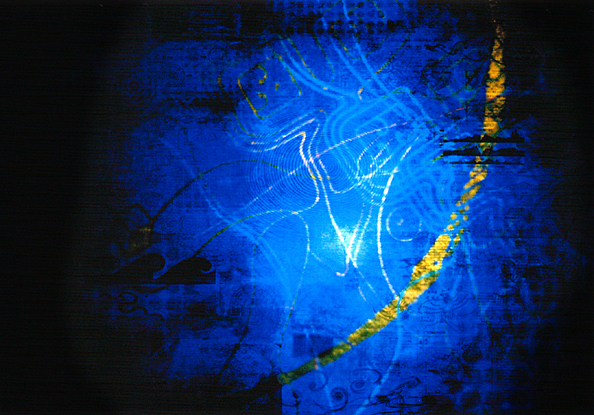
木枠に塩化ビニール, トナー, 背後にスライドプロジェクター映像, 450mm × 450mm, 1997年 / Wooden Flame, Vinyl Chloride Film, Toner, Images by slide projector in the rear, 1030mm × 1030mm, 1997.
ビニールフィルムに以前に描いたアクリル画を投影しました。アクリル画がフタロシアニンブルーをメインにして描かれていたので、深い海の底のような映像になりました。
I reflected my old work of aclylic on vinyl films. I reflected my old work of acrylic on vinyl films which forms of waves printed. As the acrylic was painted with phthalocyanine blue in Maine, so it was to be seen as in the deep sea.
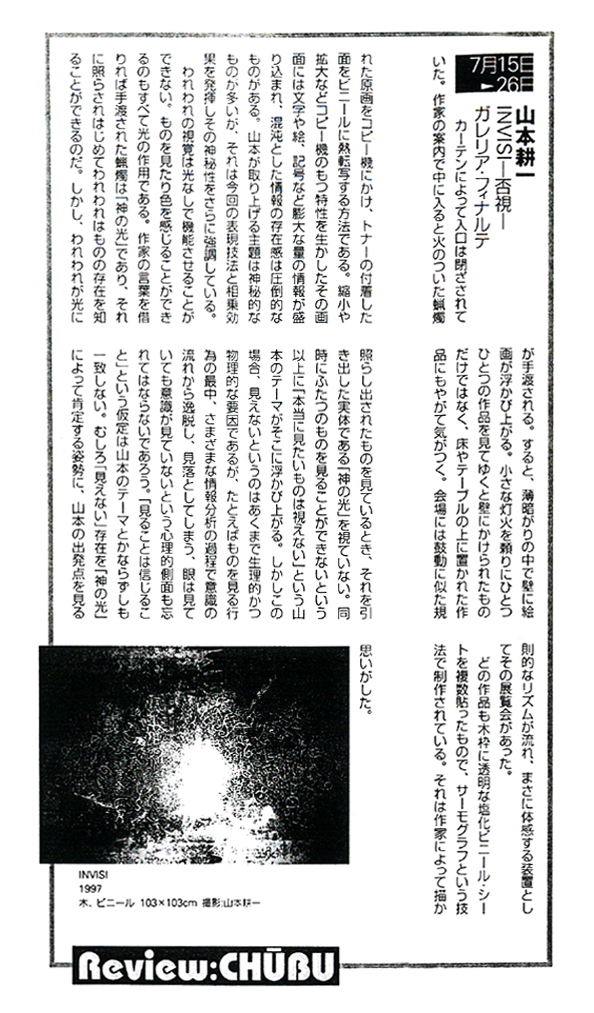
「美術手帖」の紹介記事, 1997年 / An article on this exhibition at "Bijutsu Techo(A Note On Art Scenes)", 1997.
「美術手帖」のレヴュー欄に紹介されたこの個展の記事。筆者は坪内浩文氏。概ね正確に書いていただいているが、「サーモグラフ」とあるのは、正しくは「サーモプリント」。まあ、どちらでもたいした違いはないが。
The article of this private exhibition introduced by the review column of "Bijutu Techo (A Note On Art Scenes)." The writer is Mr. Hirofumi Tsubouchi. Mention of this article is almost accurate, but the word "thermograph" isn't right. It should be "thermoprint". Oh, either makes little difference maybe. The English translation of this article is as follows.
From July 25 to 26
Yamamoto Koichi
INVISI-no seeing
Galleria Finarte
The entrance was closing by a curtain. A candle with the fire is handed when I enter with a guidance of the artist. Then, in dusk, pictures are seen on the wall. I notice that there are some works not only hung on the wall but also put on the floor and the table, before long when I watch works from one to one with the help of a small light. Regular rhythm like heart beating flowed through the room, and his work was a device to sense bodily. All works are made in the technique called "thermograph", which set up some transparent vinyl chloride sheets to a wooden frame. It is the following technique. At first, the artist draws an original picture, and he makes it's copy with copier. And then, he prints the toner of the copy by heat to the vinyl side. The printed screen makes use of the characteristic of copiers such as reduction or the expansion. Letters, pictures, signs, enormous quantity of informations are included in that screen, visitor is overwhelmed in presence of huge informations in confusion. The subject that Yamamoto uses is usually mysterious. In this display, the mysteriousness of the subject showed an expression method and synergy, and I thereby felt stronger mysteriousness. Our sight does not function without the light. It's all by the action of the light that we watch things and can feel colors. According to the words of the artist, the candle handed me is "Divine light", and he says that we can recognize the being of thing lighted up by it. However, we do not watch "the light of God" that is substance showing it when we watch a thing lighted up by the light. We cannot watch two things at the same time, but, more than it, a theme of Yamamoto "invisible as for the thing to really want to see" appears there. If anyone say "I can't see", usually it means "my sight is disturbed" by a physiological factor or a physical factor. But there is another factor of disturbing the ability of seeing. It's a psychological one. In the process of seeing, there are a lot of informations are handled, and if a part of informations dropped out from one's consciousness, a person's eyes see, but his consciousness does not see. Generally, it is said that "seeing is believing", but the theme of Yamamoto does not necessarily agree with this supposition. I think that I looked at the starting point of Yamamoto's posture affirming "invisible existence" by "light of God" rather .